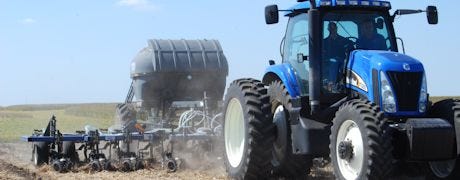April 11, 2014

Nothing sparks calls for seed delivery like a day of sunshine with 70-degree temperatures! The long, cold winter experienced across the Upper Midwest this year has everyone eagerly awaiting longer days with warmer temperatures. This past winter alone provides reason enough for farmers to want to start working in the fields.
"When you think back on the challenges we faced getting the 2013 crop in the ground, it's going to be even more tempting for farmers to race into the fields in 2014," says Nick Benson, corn product specialist, Latham Hi-Tech Seeds at Alexander, Iowa.

WAIT UNTIL: Agronomists recommend waiting until soils at 3 inch depth are 50 to 55 degrees F before planting corn. Also, make sure soil isn't too wet. Put some between your thumb and finger. If it forms a ribbon, the soil is a little too wet yet.
"Don't succumb to that temptation – at least not yet," he adds. "Last year's planting season taught us some bad habits just because rain showers didn't stop long enough for soils to truly dry in many areas. When the calendar showed mid-June and farmers still had seed in the shed, they were facing a much different situation than they were earlier in the planting season."
If soil conditions aren't fit for planting, yield will be sacrificed
It's important to base your 2014 planting decisions on logic rather than emotion, says Benson. History has proven that early planted crops perform best when conditions are fit. If planting conditions aren't fit for planting, yield potential will be sacrificed.
Yield losses often result from:
Chilling Injury – Imbibitional chilling can negatively affect both corn and soybeans, most often when farmers jump the gun and plant in soils that are too cold. For a seed to germinate, it must absorb water and that usually happens within a few hours of planting. If the water is too cold, tissue damage will occur within the seedling and will either kill it or drastically slow down emergence. This can allow diseases and other problems to enter. Typical symptoms of chilling injury may include a swollen seed that has not germinated, as well as a fragile or absent primary root.
Soil Crusting – Wet soil at planting can cause a crusted layer to form, which may delay or prevent seedling emergence. Soybean hypocotyls can easily break as they push through the crust, which may result in significant stand reductions and lower yield potential.
~~~PAGE_BREAK_HERE~~~
Soil Compaction – If mud sticks to your tires and ruts are deeper than an inch, the field is too wet to work. Soil compaction will likely result causing decreased germination as well as stunting root and plant growth. Sidewall compaction also limits nutrient uptake, and young plants need that starter fertilizer. To see a video taken last season that literally shows why it's so important to avoid wet soils, visit www.thefieldposition.com
Nutrient deficiency – Wet conditions early in the season can result in the loss of nitrogen across fields or in parts of fields, which we saw in 2013. Plants can die prematurely due to severe nitrogen deficiency. Last growing season, farmers explored options for sidedressing nitrogen and applying ammonium sulfate.
Rootworm feeding – Water and nutrient uptake by plants can be further impacted when corn rootworm larvae prune roots, placing additional stress on corn already suffering from moisture, compaction, and/or fertility stress. Roots damaged by rootworms may be weakened to the point that plants lodge or grow in gooseneck shape. These lodged plants often result in additional yield losses due to poor pollination or harvestability. In addition, corn rootworm damage often provides pathways for pathogens that cause root and/or stalk rots.
Why take on additional risk from planting in unfit conditions? Put the odds in your favor waiting for soils that are warm and dry enough for planting, says Benson. "We recommend soil temperatures of 50 to 55 degrees at corn planting time. Warm temperatures are even more critical when planting soybeans because soybeans can germinate in a soil environment of about 55 degrees Fahrenheit. If the air temperature after germination hits 28 degrees Fahrenheit or less, the young soybean seedling can be killed with the growing point of the plant right at emergence."
"Our recommendations are based on what we've learned through years of experience," he says. "Since our recommendations are tried and true, avoid making decisions based solely on last year. Hopefully, the 2013 planting season was an anomaly that won't be repeated this season."
For more information visit Latham Hi-Tech Seeds website or blog.
(Helpful LINKS):
You May Also Like




